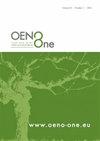气候变化背景下采收日期对梅洛、赤霞珠must和葡萄酒香气化合物组成的影响:熟果分子标记的研究
IF 2.2
3区 农林科学
Q3 FOOD SCIENCE & TECHNOLOGY
引用次数: 2
摘要
采收日期的选择可以调节草本/植物、新鲜水果和熟水果的香气强度,从而帮助酿酒师酿造出不同风格和平衡的葡萄酒。梅洛(Merlot)和赤霞珠(Cabernet-Sauvignon)葡萄的感官属性和香气化合物之间的关系,是顺序采收的,并对两个年份的葡萄酒进行了评估:2012年和2014年。采收日期的微调调节了年轻葡萄酒的香气,并影响了梅洛和赤霞珠熟果香气的强度。在煮熟的水果香气的强度方面,葡萄汁和葡萄酒之间没有观察到相关性。为了观察对熟果香气强度的影响,有必要将2012年和2014年赤霞珠的采收日期分别推迟4至12天。对于梅洛葡萄酒(2014年份),这个值是7天。呋喃酮、内酯和酮类与年轻葡萄酒中熟果香气的感知强度密切相关。此外,用晚采葡萄酿造的梅洛葡萄酒中γ-非内酯、3-甲基-2,4-壬二酮、马尾内酯和呋喃醇的含量最高。在测量的浓度下,这些化合物可以解释在红酒中检测到的煮熟水果的香气。用晚熟葡萄酿造的赤霞珠葡萄酒也得到了类似的结果。据推测,葡萄中脂氧合酶途径产生的挥发性化合物参与了连续采收日期后红酒香气的演变,这为通过采收日期决定管理香气谱提供了可能性。这些发现很重要,因为确定葡萄中可测量的关键化学参数可以为葡萄种植者和酿酒师提供预测最终葡萄酒风格和质量的客观指标。本文章由计算机程序翻译,如有差异,请以英文原文为准。
Impact of harvest date on aroma compound composition of Merlot and Cabernet-Sauvignon must and wine in a context of climate change: a focus on cooked fruit molecular markers
Choice of harvest date can modulate the aroma intensity of herbaceous/vegetal, fresh fruit and cooked fruit nuances, thus helping the winemaker to produce wine of different styles and balance. Relationships between the sensory attributes and aroma compounds of Merlot and Cabernet-Sauvignon grapes that were harvested sequentially and the resulting wines were evaluated for two vintages: 2012 and 2014. The fine-tuning of the harvest date modulated the aromas of the young wine and impacted the intensity of the cooked fruit aromas for both Merlot and Cabernet-Sauvignon. No correlation was observed between the must and wine in terms of the intensity of the cooked fruit aroma. In order to observe an impact on the intensity of the cooked fruit aroma it was necessary to delay the harvest date of Cabernet-Sauvignon by 4 to 12 days in 2012 and 2014 respectively. This value was 7 days for Merlot wines (2014 vintage). Furanones, lactone and ketones were well correlated with the perceived intensity of the cooked fruit aroma in the young wine. In addition, the highest concentrations of γ-nonalactone, 3-methyl-2,4-nonanedione, massoia lactone and furaneol were detected in Merlot wines made using late-harvested grapes. At the measured concentrations, these compounds can explain the aroma of cooked fruit detected in the red wines. Similar results were obtained for the Cabernet-Sauvignon wines made from grapes from a later harvest. The volatile compounds produced from the lipoxygenase pathway in the grapes were putatively involved in the evolution of the aroma of the red wines from sequential harvest dates, opening up the possibility of managing aroma profiles through harvest date decisions. These findings are important, as the identification of measurable key chemical parameters in grapes could provide grape growers and winemakers objective indicators for predicting final wine style and quality.
求助全文
通过发布文献求助,成功后即可免费获取论文全文。
去求助
来源期刊

OENO One
Agricultural and Biological Sciences-Food Science
CiteScore
4.40
自引率
13.80%
发文量
85
审稿时长
13 weeks
期刊介绍:
OENO One is a peer-reviewed journal that publishes original research, reviews, mini-reviews, short communications, perspectives and spotlights in the areas of viticulture, grapevine physiology, genomics and genetics, oenology, winemaking technology and processes, wine chemistry and quality, analytical chemistry, microbiology, sensory and consumer sciences, safety and health. OENO One belongs to the International Viticulture and Enology Society - IVES, an academic association dedicated to viticulture and enology.
 求助内容:
求助内容: 应助结果提醒方式:
应助结果提醒方式:


